
Michelangelo di Lodovico Buonarroti Simoni, known simply as Michelangelo, was an Italian sculptor, painter, architect and poet of the High Renaissance. Born in the Republic of Florence, his work had a major influence on the development of Western art, particularly in relation to the Renaissance notions of humanism and naturalism. He is often considered a contender for the title of the archetypal Renaissance man, along with his rival and elder contemporary, Leonardo da Vinci. Given the sheer volume of surviving correspondence, sketches, and reminiscences, Michelangelo is one of the best-documented artists of the 16th century and several scholars have described Michelangelo as the most accomplished artist of his era.

Nicolas Poussin was the leading painter of the classical French Baroque style, although he spent most of his working life in Rome. Most of his works were on religious and mythological subjects painted for a small group of Italian and French collectors. He returned to Paris for a brief period to serve as First Painter to the King under Louis XIII and Cardinal Richelieu, but soon returned to Rome and resumed his more traditional themes. In his later years he gave growing prominence to the landscape in his paintings. His work is characterized by clarity, logic, and order, and favors line over color. Until the 20th century he remained a major inspiration for such classically-oriented artists as Jacques-Louis David, Jean-Auguste-Dominique Ingres and Paul Cézanne.

Alessandro di Mariano di Vanni Filipepi, known as Sandro Botticelli, was an Italian painter of the Early Renaissance. Botticelli's posthumous reputation suffered until the late 19th century, when he was rediscovered by the Pre-Raphaelites who stimulated a reappraisal of his work. Since then, his paintings have been seen to represent the linear grace of late Italian Gothic and some Early Renaissance painting, even though they date from the latter half of the Italian Renaissance period.
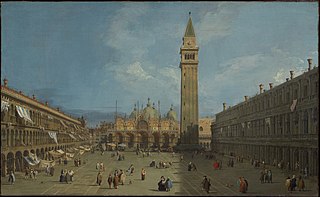
Piazza San Marco, often known in English as St Mark's Square, is the principal public square of Venice, Italy, where it is generally known just as la Piazza. All other urban spaces in the city are called campi ("fields"). The Piazzetta is an extension of the Piazza towards San Marco basin in its south east corner. The two spaces together form the social, religious and political centre of Venice and are commonly considered together. This article relates to both of them.

Tiziano Vecelli or Vecellio, known in English as Titian, was an Italian (Venetian) painter of the Renaissance, considered the most important member of the 16th-century Venetian school. He was born in Pieve di Cadore, near Belluno. During his lifetime he was often called da Cadore, 'from Cadore', taken from his native region.

Paolo Caliari, known as Paolo Veronese, was an Italian Renaissance painter based in Venice, known for extremely large history paintings of religion and mythology, such as The Wedding at Cana (1563) and The Feast in the House of Levi (1573). Included with Titian, a generation older, and Tintoretto, a decade senior, Veronese is one of the "great trio that dominated Venetian painting of the cinquecento" and the Late Renaissance in the 16th century. Known as a supreme colorist, and after an early period with Mannerism, Paolo Veronese developed a naturalist style of painting, influenced by Titian.
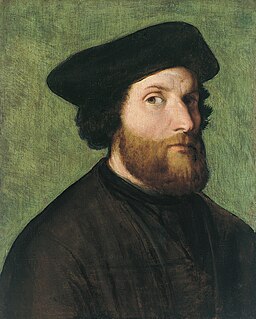
Lorenzo Lotto was an Italian painter, draughtsman, and illustrator, traditionally placed in the Venetian school, though much of his career was spent in other north Italian cities. He painted mainly altarpieces, religious subjects and portraits. He was active during the High Renaissance and the first half of the Mannerist period, but his work maintained a generally similar High Renaissance style throughout his career, although his nervous and eccentric posings and distortions represented a transitional stage to the Florentine and Roman Mannerists.
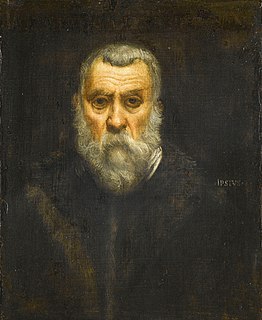
Tintoretto was an Italian painter identified with the Venetian school. His contemporaries both admired and criticized the speed with which he painted, and the unprecedented boldness of his brushwork. For his phenomenal energy in painting he was termed Il Furioso. His work is characterised by his muscular figures, dramatic gestures and bold use of perspective, in the Mannerist style.
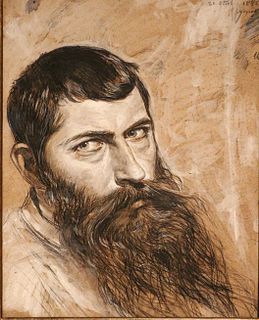
Vincenzo Gemito was an Italian sculptor and artist.

The Virgin of the Rocks, sometimes the Madonna of the Rocks, is the name of two paintings by the Italian Renaissance artist Leonardo da Vinci, of the same subject, with a composition which is identical except for several significant details. The version generally considered the prime version, the earlier of the two, is unrestored and hangs in the Louvre in Paris. The other, which was restored between 2008 and 2010, hangs in the National Gallery, London. The works are often known as the Louvre Virgin of the Rocks and London Virgin of the Rocks respectively. The paintings are both nearly 2 metres high and are painted in oils. Both were originally painted on wooden panels, but the Louvre version has been transferred to canvas.

The Holy Family consists of the Child Jesus, the Virgin Mary and Saint Joseph. The subject became popular in art from the 1490s on, but veneration of the Holy Family was formally begun in the 17th century by Saint François de Laval, the first bishop of New France, who founded a confraternity.

Dieric Bouts was an Early Netherlandish painter. Bouts may have studied under Rogier van der Weyden, and his work was influenced by van der Weyden and Jan van Eyck. He worked in Leuven from 1457 until his death in 1475.

Euphronios was an ancient Greek vase painter and potter, active in Athens in the late 6th and early 5th centuries BC. As part of the so-called "Pioneer Group,", Euphronios was one of the most important artists of the red-figure technique. His works place him at the transition from Late Archaic to Early Classical art, and he is one of the first known artists in history to have signed his work.
Yves Chaudron was a supposed French master art forger who is alleged to have copied images of Leonardo da Vinci's Mona Lisa as part of Eduardo de Valfierno's famous 1911 Mona Lisa painting theft. In reality he may be a fictional character created by Karl Decker for an article that ran in a 1932 issue of the Saturday Evening Post, and passed off as a real person. There is also very little evidence that Valfierno actually existed, or if he did, that he was involved in the theft of the Mona Lisa at all.

Cornelis Corneliszoon van Haarlem was a Dutch Golden Age painter and draughtsman, one of the leading Northern Mannerist artists in the Netherlands, and an important forerunner of Frans Hals as a portraitist.

The Palazzo Grimani of Santa Maria Formosa is a State museum, located in Venice in the Castello district, near Campo Santa Maria Formosa.
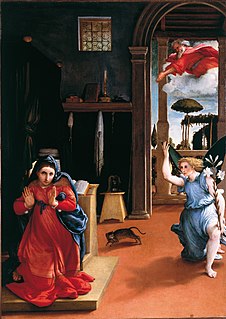
The Recanati Annunciation is a painting by the Italian Renaissance painter Lorenzo Lotto, executed around 1534 and housed in the Civic Museum of Villa Colloredo Mels, Recanati, Italy.

The Rebellious Slave is a 2.15m high marble statue by Michelangelo, dated to 1513. It is now held in the Louvre in Paris.

Hans Holbein the Younger painted the Portrait of Erasmus of Rotterdam several times, and his paintings were much copied, at the time and later. It is difficult to disentangle Holbein's original work from that of his workshop and other copyists. Possibly five largely original versions survive, as well as a number of drawings made as studies.

Willem van den Broecke, Willem van den Broeck or Guillelmus Paludanus was a Flemish sculptor, painter, draughtsman and architect. He was a scion of a family of artists, which had its origins in Mechelen and some members of which later moved to Antwerp. Willem was active in Antwerp and also worked and likely trained in Italy for a long period. He was known for his small scale works, many of which were executed in alabaster. He was, along with Cornelis Floris, the leading sculptor in Antwerp in the second half of the 16th century. He was also one of the designers of the Antwerp City Hall. He enjoyed the patronage of an elite international clientele of church institutions, Spanish nobility, princes of Protestant territories as well as patricians from Augsburg.



















